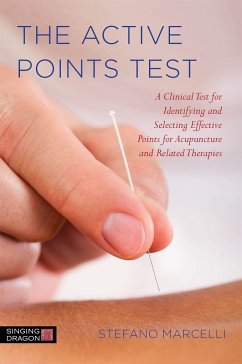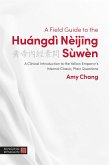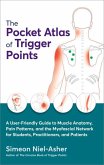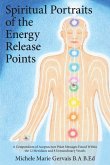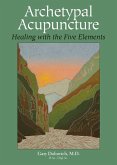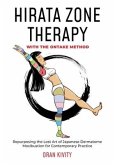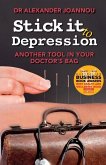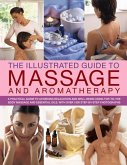Stefano Marcelli
The Active Points Test
A Clinical Test for Identifying and Selecting Effective Points for Acupuncture and Related Therapies
Schade – dieser Artikel ist leider ausverkauft. Sobald wir wissen, ob und wann der Artikel wieder verfügbar ist, informieren wir Sie an dieser Stelle.
Stefano Marcelli
The Active Points Test
A Clinical Test for Identifying and Selecting Effective Points for Acupuncture and Related Therapies
- Broschiertes Buch
- Merkliste
- Auf die Merkliste
- Bewerten Bewerten
- Teilen
- Produkt teilen
- Produkterinnerung
- Produkterinnerung
Dr Stefano Marcelli sets out the theory of The Active Points Test, providing a comprehensive and effective system for point selection. Offering detailed guidance on how to carry out the test and interpret the results, this is essential reading for practitioners and students of acupuncture and related reflex and manual therapies.
Andere Kunden interessierten sich auch für
![A Field Guide to the Huángdì Nèijing Sùwèn A Field Guide to the Huángdì Nèijing Sùwèn]() Amy ChangA Field Guide to the Huángdì Nèijing Sùwèn39,99 €
Amy ChangA Field Guide to the Huángdì Nèijing Sùwèn39,99 €![The Pocket Atlas of Trigger Points The Pocket Atlas of Trigger Points]() Simeon Niel-AsherThe Pocket Atlas of Trigger Points15,99 €
Simeon Niel-AsherThe Pocket Atlas of Trigger Points15,99 €![Spiritual Portraits of the Energy Release Points Spiritual Portraits of the Energy Release Points]() Michele Marie GervaisSpiritual Portraits of the Energy Release Points40,99 €
Michele Marie GervaisSpiritual Portraits of the Energy Release Points40,99 €![Archetypal Acupuncture: Healing with the Five Elements Archetypal Acupuncture: Healing with the Five Elements]() Gary DolowichArchetypal Acupuncture: Healing with the Five Elements17,99 €
Gary DolowichArchetypal Acupuncture: Healing with the Five Elements17,99 €![Hirata Zone Therapy with the Ontake Method Hirata Zone Therapy with the Ontake Method]() Oran KivityHirata Zone Therapy with the Ontake Method26,99 €
Oran KivityHirata Zone Therapy with the Ontake Method26,99 €![Stick it to Depression Stick it to Depression]() Alexander JoannouStick it to Depression14,99 €
Alexander JoannouStick it to Depression14,99 €![The Illustrated Guide to Massage and Aromatherapy: A Practical Guide to Achieving Relaxation and Well-Being, Using Top-To-Toe Body Massage and Essenti The Illustrated Guide to Massage and Aromatherapy: A Practical Guide to Achieving Relaxation and Well-Being, Using Top-To-Toe Body Massage and Essenti]() The Illustrated Guide to Massage and Aromatherapy: A Practical Guide to Achieving Relaxation and Well-Being, Using Top-To-Toe Body Massage and Essenti17,99 €
The Illustrated Guide to Massage and Aromatherapy: A Practical Guide to Achieving Relaxation and Well-Being, Using Top-To-Toe Body Massage and Essenti17,99 €
Dr Stefano Marcelli sets out the theory of The Active Points Test, providing a comprehensive and effective system for point selection. Offering detailed guidance on how to carry out the test and interpret the results, this is essential reading for practitioners and students of acupuncture and related reflex and manual therapies.
Produktdetails
- Produktdetails
- Verlag: Jessica Kingsley Publishers
- Seitenzahl: 208
- Erscheinungstermin: 21. September 2014
- Englisch
- Abmessung: 248mm x 134mm x 12mm
- Gewicht: 340g
- ISBN-13: 9781848192331
- ISBN-10: 1848192339
- Artikelnr.: 40888921
- Herstellerkennzeichnung
- Libri GmbH
- Europaallee 1
- 36244 Bad Hersfeld
- gpsr@libri.de
- Verlag: Jessica Kingsley Publishers
- Seitenzahl: 208
- Erscheinungstermin: 21. September 2014
- Englisch
- Abmessung: 248mm x 134mm x 12mm
- Gewicht: 340g
- ISBN-13: 9781848192331
- ISBN-10: 1848192339
- Artikelnr.: 40888921
- Herstellerkennzeichnung
- Libri GmbH
- Europaallee 1
- 36244 Bad Hersfeld
- gpsr@libri.de
Stefano Marcelli graduated from the University of Bologna with a degree in Medicine and Surgery in 1982. He has since trained in Acupuncture, Auricular therapy and Mesotherapy in Italy, France and China. He initiated the anatomical comparative approach in acupuncture research. He is the founder of the Italian School of Mesotherapy and has written ten books on acupuncture and Mesotherapy. He lives in Darfo Boario Terme (Brescia), Italy.
Foreword by David Alimi, MD. Foreword by Dr Ioan Florin Dumitrescu. 1. The
Test. 1.1. Definition and particulars. 1.2. Indications for and limitations
of the Test. 1.3. Therapies for which the Test is useful. 1.4. An ex
adiuvantibus criterion. 1.5. Kinesiology and Applied Kinesiology. 1.6.
Other tests in acupuncture. 1.7. The Acupuncture Energy System. 1.8. The
difficulties of acupuncture. 2. Practice. 2.1. Initial question. 2.2. Final
observations. 2.3. One nail drives out another. 2.4. Materials. 2.5.
Cleaning and disinfection of the skin. 1. Classification of the symptom. 2.
Explanations and instructions to patient. 3. Looking for the painful
points. 4. Execution of the Test and results. 2.7. The Test's persistent
activity effect. 2.8. Size and electrical characteristics of the points.
2.9. Distance between the points. 2.10. Clinical-statistical observation
evidence. 2.11. Non responders. 3. Choosing Points. 3.1. Two criteria for
choosing. 3.2. Quick choice points. 1. Local points. 2. Paravertebral
points. 3. Spondyloid points. 3.4. Traditional Chinese Acupuncture, tuina
and shiatsu. The Extraordinary Channels. Functional groups of acupuncture
points. 3.5. A few more words about palpation. 3.6. Auricular puncture.
3.7. Mesotherapy. 3.8. Neural therapy. 3.9. Western manual therapies. 3.10.
Medical history and blind acupuncture. 3.11. Duration of the Test (how many
points should be found active). 3.12. Acupoint formulas. Chewing and
digestive system. Genito-urinary system. Cardiocirculatory system.
Locomotive system. Nervous system. Cutaneous system. Ears and eyes. 4.
Explanation. 4.1. Neurophysiological interpretation of the Test. 4.2. The
Qi interpretation. 4.3. Placebo and nocebo effects. 4.4. Psychological
implications. 5. Therapy. 5.1. Therapy following the Test. Acupuncture and
the cross-shaped pattern. Auriculo puncture. Mesotherapy. Neural therapy.
Manual techniques. 5.2. In summary. 5.3. Clinical cases. 5.4. Discussion
and conclusions. 6. Perspectives. 6.1. Use of the Test in borderline cases.
6.2. Self-administration. 6.3. Towards a more rational therapy. 7. Expert
Opinions. 7.1. In order of arrival. 8. The Active Points Test in auricular
puncture. Preface to the second edition. Outline. Examination of the
auricule and application of the Test. Case study. Biographical references.
Web links and bibliography. Index.
Test. 1.1. Definition and particulars. 1.2. Indications for and limitations
of the Test. 1.3. Therapies for which the Test is useful. 1.4. An ex
adiuvantibus criterion. 1.5. Kinesiology and Applied Kinesiology. 1.6.
Other tests in acupuncture. 1.7. The Acupuncture Energy System. 1.8. The
difficulties of acupuncture. 2. Practice. 2.1. Initial question. 2.2. Final
observations. 2.3. One nail drives out another. 2.4. Materials. 2.5.
Cleaning and disinfection of the skin. 1. Classification of the symptom. 2.
Explanations and instructions to patient. 3. Looking for the painful
points. 4. Execution of the Test and results. 2.7. The Test's persistent
activity effect. 2.8. Size and electrical characteristics of the points.
2.9. Distance between the points. 2.10. Clinical-statistical observation
evidence. 2.11. Non responders. 3. Choosing Points. 3.1. Two criteria for
choosing. 3.2. Quick choice points. 1. Local points. 2. Paravertebral
points. 3. Spondyloid points. 3.4. Traditional Chinese Acupuncture, tuina
and shiatsu. The Extraordinary Channels. Functional groups of acupuncture
points. 3.5. A few more words about palpation. 3.6. Auricular puncture.
3.7. Mesotherapy. 3.8. Neural therapy. 3.9. Western manual therapies. 3.10.
Medical history and blind acupuncture. 3.11. Duration of the Test (how many
points should be found active). 3.12. Acupoint formulas. Chewing and
digestive system. Genito-urinary system. Cardiocirculatory system.
Locomotive system. Nervous system. Cutaneous system. Ears and eyes. 4.
Explanation. 4.1. Neurophysiological interpretation of the Test. 4.2. The
Qi interpretation. 4.3. Placebo and nocebo effects. 4.4. Psychological
implications. 5. Therapy. 5.1. Therapy following the Test. Acupuncture and
the cross-shaped pattern. Auriculo puncture. Mesotherapy. Neural therapy.
Manual techniques. 5.2. In summary. 5.3. Clinical cases. 5.4. Discussion
and conclusions. 6. Perspectives. 6.1. Use of the Test in borderline cases.
6.2. Self-administration. 6.3. Towards a more rational therapy. 7. Expert
Opinions. 7.1. In order of arrival. 8. The Active Points Test in auricular
puncture. Preface to the second edition. Outline. Examination of the
auricule and application of the Test. Case study. Biographical references.
Web links and bibliography. Index.
Foreword by David Alimi, MD. Foreword by Dr Ioan Florin Dumitrescu. 1. The
Test. 1.1. Definition and particulars. 1.2. Indications for and limitations
of the Test. 1.3. Therapies for which the Test is useful. 1.4. An ex
adiuvantibus criterion. 1.5. Kinesiology and Applied Kinesiology. 1.6.
Other tests in acupuncture. 1.7. The Acupuncture Energy System. 1.8. The
difficulties of acupuncture. 2. Practice. 2.1. Initial question. 2.2. Final
observations. 2.3. One nail drives out another. 2.4. Materials. 2.5.
Cleaning and disinfection of the skin. 1. Classification of the symptom. 2.
Explanations and instructions to patient. 3. Looking for the painful
points. 4. Execution of the Test and results. 2.7. The Test's persistent
activity effect. 2.8. Size and electrical characteristics of the points.
2.9. Distance between the points. 2.10. Clinical-statistical observation
evidence. 2.11. Non responders. 3. Choosing Points. 3.1. Two criteria for
choosing. 3.2. Quick choice points. 1. Local points. 2. Paravertebral
points. 3. Spondyloid points. 3.4. Traditional Chinese Acupuncture, tuina
and shiatsu. The Extraordinary Channels. Functional groups of acupuncture
points. 3.5. A few more words about palpation. 3.6. Auricular puncture.
3.7. Mesotherapy. 3.8. Neural therapy. 3.9. Western manual therapies. 3.10.
Medical history and blind acupuncture. 3.11. Duration of the Test (how many
points should be found active). 3.12. Acupoint formulas. Chewing and
digestive system. Genito-urinary system. Cardiocirculatory system.
Locomotive system. Nervous system. Cutaneous system. Ears and eyes. 4.
Explanation. 4.1. Neurophysiological interpretation of the Test. 4.2. The
Qi interpretation. 4.3. Placebo and nocebo effects. 4.4. Psychological
implications. 5. Therapy. 5.1. Therapy following the Test. Acupuncture and
the cross-shaped pattern. Auriculo puncture. Mesotherapy. Neural therapy.
Manual techniques. 5.2. In summary. 5.3. Clinical cases. 5.4. Discussion
and conclusions. 6. Perspectives. 6.1. Use of the Test in borderline cases.
6.2. Self-administration. 6.3. Towards a more rational therapy. 7. Expert
Opinions. 7.1. In order of arrival. 8. The Active Points Test in auricular
puncture. Preface to the second edition. Outline. Examination of the
auricule and application of the Test. Case study. Biographical references.
Web links and bibliography. Index.
Test. 1.1. Definition and particulars. 1.2. Indications for and limitations
of the Test. 1.3. Therapies for which the Test is useful. 1.4. An ex
adiuvantibus criterion. 1.5. Kinesiology and Applied Kinesiology. 1.6.
Other tests in acupuncture. 1.7. The Acupuncture Energy System. 1.8. The
difficulties of acupuncture. 2. Practice. 2.1. Initial question. 2.2. Final
observations. 2.3. One nail drives out another. 2.4. Materials. 2.5.
Cleaning and disinfection of the skin. 1. Classification of the symptom. 2.
Explanations and instructions to patient. 3. Looking for the painful
points. 4. Execution of the Test and results. 2.7. The Test's persistent
activity effect. 2.8. Size and electrical characteristics of the points.
2.9. Distance between the points. 2.10. Clinical-statistical observation
evidence. 2.11. Non responders. 3. Choosing Points. 3.1. Two criteria for
choosing. 3.2. Quick choice points. 1. Local points. 2. Paravertebral
points. 3. Spondyloid points. 3.4. Traditional Chinese Acupuncture, tuina
and shiatsu. The Extraordinary Channels. Functional groups of acupuncture
points. 3.5. A few more words about palpation. 3.6. Auricular puncture.
3.7. Mesotherapy. 3.8. Neural therapy. 3.9. Western manual therapies. 3.10.
Medical history and blind acupuncture. 3.11. Duration of the Test (how many
points should be found active). 3.12. Acupoint formulas. Chewing and
digestive system. Genito-urinary system. Cardiocirculatory system.
Locomotive system. Nervous system. Cutaneous system. Ears and eyes. 4.
Explanation. 4.1. Neurophysiological interpretation of the Test. 4.2. The
Qi interpretation. 4.3. Placebo and nocebo effects. 4.4. Psychological
implications. 5. Therapy. 5.1. Therapy following the Test. Acupuncture and
the cross-shaped pattern. Auriculo puncture. Mesotherapy. Neural therapy.
Manual techniques. 5.2. In summary. 5.3. Clinical cases. 5.4. Discussion
and conclusions. 6. Perspectives. 6.1. Use of the Test in borderline cases.
6.2. Self-administration. 6.3. Towards a more rational therapy. 7. Expert
Opinions. 7.1. In order of arrival. 8. The Active Points Test in auricular
puncture. Preface to the second edition. Outline. Examination of the
auricule and application of the Test. Case study. Biographical references.
Web links and bibliography. Index.

